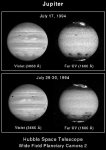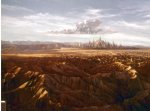Fake Auroras?: II
reading comprehension pwns you.
from the Hubble mission site:
((HubbleSite: News - Hubble Captures Vivid Auroras in Jupiter's Atmosphere))
ignorance of how cameras work pwns you.
the Hubble telescope pointed its far-ultraviolet imaging apparatus at Jupiter.
obviously ((to someone with a basic knowledge of optical physics)) the visible-light image of the planet is not taken with the same instrumentation.
the ultraviolet spectrograph information recorded by Hubble was combined with information from the Juno craft approaching Jupiter, processed, and superimposed on an existing visible-light image for press release. that's never been a 'secret' and isn't being 'buried' by anyone. it's right there in the articles you had open on your computer but failed to actually read.
Thank you kindly for the clarification/correction on my lack of reading abilities. Very often I skim through articles and I overlook details. My sincerest apologies.
Concerning ultraviolet imaging...why overlay an aurora image over an old stock photo, and then add a disclaimer? Why not show the full UV image from Juno/Hubble? I still believe NASA is lying, deceiving, whatever you'd like to call it. I see no reason to believe anything they say, print, or portray as real...including the pictures I've posted below...press release or not.
https://www.nasa.gov/feature/goddard/2016/hubble-captures-vivid-auroras-in-jupiter-s-atmosphere
"Jupiter, the largest planet in the solar system, is best known for its colorful storms, the most famous being the Great Red Spot. Now astronomers have focused on another beautiful feature of the planet, using Hubble's ultraviolet capabilities."
"The auroras were photographed during a series of Hubble Space Telescope Imaging Spectrograph far-ultraviolet-light observations taking place as NASA's Juno spacecraft approaches and enters into orbit around Jupiter."
So, are these new Juno images/readings, or new Hubble images? Has the Hubble been significantly upgraded since 1994, or, is it just another NASA CGI / Art Department con?
Again, I did not read the article fully. I saw something out of place and I posted it. Unfortunately I don't have the original page to look at. It's possible that NASA put in the disclaimer/edit after someone noticed the old stock photo, or the disclaimer could have been there from the web page inception.
On further investigation, it does seem that the page has been modified August 4th, 2017...of course that proves nothing.

https://www.spacetelescope.org/images/opo9444a/
Top
Three impact sites appear as dark smudges lined up along Jupiter's southern hemisphere (from left to right, sites C, A, and E). This pair of images was obtained on 17 July, several hours after the E impact. These 3 impact sites appear strikingly darker in the far-ultraviolet images to the right. This is because the smoke and dust rising from the fireballs absorbs UV light more strongly than violet light, so that the clouds appear both darker and larger in the UV images. Apparently, the fireball and plume threw large amounts of material completely above the atmosphere. This material diffused back down through the atmosphere with the smaller and lighter particles suspended at high altitudes.
Bottom
Rubble's view of the same hemisphere of Jupiter 12-13 days later shows that the smoke and dust have now been spread mainly in the east/west direction by die prevailing winds at the altitude where the dark material is suspended or "floating" in the atmosphere.

Draw your own conclusions.
Peace.
reading comprehension pwns you.
from the Hubble mission site:
The auroras were photographed during a series of Hubble Space Telescope Imaging Spectrograph far-ultraviolet-light observations taking place as NASA's Juno spacecraft approaches and enters into orbit around Jupiter.
. . .
"The full-color disk of Jupiter in this image was separately photographed at a different time by Hubble's Outer Planet Atmospheres Legacy (OPAL) program, a long-term Hubble project that annually captures global maps of the outer planets."
. . .
"The full-color disk of Jupiter in this image was separately photographed at a different time by Hubble's Outer Planet Atmospheres Legacy (OPAL) program, a long-term Hubble project that annually captures global maps of the outer planets."
((HubbleSite: News - Hubble Captures Vivid Auroras in Jupiter's Atmosphere))
ignorance of how cameras work pwns you.
the Hubble telescope pointed its far-ultraviolet imaging apparatus at Jupiter.
obviously ((to someone with a basic knowledge of optical physics)) the visible-light image of the planet is not taken with the same instrumentation.
the ultraviolet spectrograph information recorded by Hubble was combined with information from the Juno craft approaching Jupiter, processed, and superimposed on an existing visible-light image for press release. that's never been a 'secret' and isn't being 'buried' by anyone. it's right there in the articles you had open on your computer but failed to actually read.
Thank you kindly for the clarification/correction on my lack of reading abilities. Very often I skim through articles and I overlook details. My sincerest apologies.
Concerning ultraviolet imaging...why overlay an aurora image over an old stock photo, and then add a disclaimer? Why not show the full UV image from Juno/Hubble? I still believe NASA is lying, deceiving, whatever you'd like to call it. I see no reason to believe anything they say, print, or portray as real...including the pictures I've posted below...press release or not.
https://www.nasa.gov/feature/goddard/2016/hubble-captures-vivid-auroras-in-jupiter-s-atmosphere
"Jupiter, the largest planet in the solar system, is best known for its colorful storms, the most famous being the Great Red Spot. Now astronomers have focused on another beautiful feature of the planet, using Hubble's ultraviolet capabilities."
"The auroras were photographed during a series of Hubble Space Telescope Imaging Spectrograph far-ultraviolet-light observations taking place as NASA's Juno spacecraft approaches and enters into orbit around Jupiter."
So, are these new Juno images/readings, or new Hubble images? Has the Hubble been significantly upgraded since 1994, or, is it just another NASA CGI / Art Department con?
Again, I did not read the article fully. I saw something out of place and I posted it. Unfortunately I don't have the original page to look at. It's possible that NASA put in the disclaimer/edit after someone noticed the old stock photo, or the disclaimer could have been there from the web page inception.
On further investigation, it does seem that the page has been modified August 4th, 2017...of course that proves nothing.

https://www.spacetelescope.org/images/opo9444a/
Top
Three impact sites appear as dark smudges lined up along Jupiter's southern hemisphere (from left to right, sites C, A, and E). This pair of images was obtained on 17 July, several hours after the E impact. These 3 impact sites appear strikingly darker in the far-ultraviolet images to the right. This is because the smoke and dust rising from the fireballs absorbs UV light more strongly than violet light, so that the clouds appear both darker and larger in the UV images. Apparently, the fireball and plume threw large amounts of material completely above the atmosphere. This material diffused back down through the atmosphere with the smaller and lighter particles suspended at high altitudes.
Bottom
Rubble's view of the same hemisphere of Jupiter 12-13 days later shows that the smoke and dust have now been spread mainly in the east/west direction by die prevailing winds at the altitude where the dark material is suspended or "floating" in the atmosphere.

Draw your own conclusions.
Peace.







